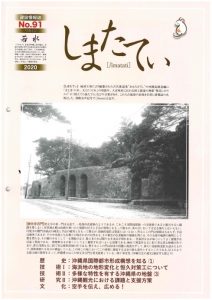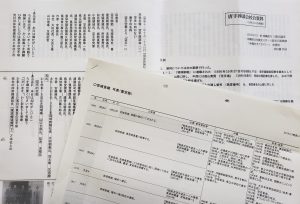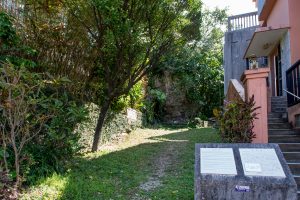The Okinawa Shimatate Association (official website in Japanese) has been in activity since 1985. It edits and publishes a construction information magazine titled “Shimatati”. First published in 1996, it is a quarterly issued in 3,300 copies.
In issue no. 91 (January 2020), an article titled “Karate wo tsutae, hiromeru! (Translation: To pass down, and spread karate!) was published. The article is authored by Sakihara Kyoko and Nakamura Akira from the OPG Karate Promotion Division. The article (PDF format) is available only in Japanese.
Here is a translation of this article by karateka and translator Mario Mckenna
Since last year, the Okinawa Prefecture Karate promotion division has been holding sessions under the label "Okinawa Karate Academy". The research reports of the previous fiscal year's sessions have been published on the website of the division.
https://www.pref.okinawa.jp/site/bunka-sports/bunka/karate/okinawakarateacademy.html
We have published an article regarding the recent first dan grading test held at the Okinawa Prefectural Police Academy on August 29th.
On March 7th and 8th, 2019, the Ryūkyū Shinpō Newspaper published a cultural column titled “Easy to understand Okinawan history - Interpreting social changes.” The author is Mr. Kurima Yasuo. Born in 1941 in Naha City, he is an Okinawa historian, agricultural scientist and emeritus professor at Okinawa International University.
In this article, professor Kurima writes about the “Katana-gari” or sword hunt that is said to have occurred at the time of King Shō Shin (1465 - 1527). The event is often mentioned in the history of Okinawa karate. Therefore we take the liberty to reproduce a part of the article in Japanese and present a translation below.
(……)
First of all, let's introduce the most detailed description of official history available in the “Achievements of Shō Shin – ‘Kyūyō’”. The Kyūyō Study Group has read through the ‘Kyūyō’ and compiled 33 points. The fourth point reads as follows. (……)
(4) Swords, bows and arrows were stored to prepare for the defense of our kingdom.
(……)
Next, let's look at the inscription “Momo Urasoe Rankan no Mei”. This asset has not survive history and its author is unknown. Yet, this inscription written in Chinese is mentioned in the "Ryūkyū Kokuhi Bunki". The inscription praises the achievements of King Shō Shin, with 11 items being listed. Some of them are also featured in "Kyūyō". (……)
ⓔ Swords, bows, arrows and similar weapon articles were collected and used exclusively for the defense of the nation.
Were the weapons surrendered?
From ④ and ⓔ, until now, there was an understanding that Shuri Royal Court itself had given up arms, but it was pointed out by many researchers that it was not the case. This is not a royal weapon abandonment, but a statement that the royal court seized weapons in its sole hand. This is fine as an interpretation of the phrase.
Since weapons were collected, some say it was a "sword hunt". If you do not clarify the distinction from the “sword hunt” in Japanese history, it can lead to a misunderstanding. In Japanese history, there was a sword hunt in Toyotomi Hideyoshi's era. However, weapons were not taken away from samurai, but from peasants (farmers) in order to clarify the distinction of social status. In the case of Ryūkyū, it is said that weapons were taken away from "Aji (1)" which are regarded as "Samurai."
So, were weapons really taken away from Aji? Originally, there was no organized armed group in Ryūkyū. While it is undeniable that there must have been some weapons, it is most likely that they were no important items for Aji. From the fact that there was really no weapon stocked, it is hard to believe that the weapons’ recall was written out as an achievement of King Shō Shin. (……)
(1) Local chieftain
In 1522, Nakasone Toyomiya Genga of Miyako donated a treasured sword to the king (1). As the king's guardian sword, it was named Jiganemaru (2).
Kyō Ahagon Jikki, (birth and death dates unknown) was entrusted with King Shō Shin’s precious sword and travelled to Kyōto to have it examined. In Kyōto, he contracted a sword sharpener and after the task was completed, he successfully brought the treasured sword back to the king.
However, it turned out that the sword that he brought back was replaced for another one by the sword sharpener. So fine was the Jiganemaru that it raised the desire of the sharpener. Realizing that the sword he brought back to Ryūkyū wasn’t the original one, Kyō Ahagon returned to Kyōto. After three years of search for the sword, he finally found it and succeeded in bringing it home safely.
The king was delighted and gave Kyō Ahagon many rewards. The fame of Kyō Ahagon’s bravery increased more and more. The more the fame rises, the more people would envy him until they were finally able to attract the attention of the king. As he could not punish Kyō Ahagon on false charge, the king invited him to the court room for a chat, offering him some tea. After a while, a young man looking for an opportunity moved forward and stabbed Kyō Ahagon with a dagger.
This story is written in the book “Kyūyō”, retracing the history of the Ryūkyū. In the part depicting the episode, it is written as follow. “He broke the youth's femora (3) using karate (4)”. While it is unclear if karate was studied as a martial art, at that time, Chinese were already established in the Ryūkyū. Furthermore, since 1372, tribute trade was actively being held, it can be imagined that Chinese martial arts influences on the local art of Tī were happening. All this make this record quite interesting.
Episodes about Kyō Ahagon can also be found in the books “Ryūkyū Yūraiki” (1713) and “Ryūkyū koku Kūki” (1731).
It is unknown if the historical figure Kyō Ahagon Jikki was a disciple of karate. Yet, his grave is still preserved in Shuri. It is located in Shuri Samukawa, behind the Mezura Dake - peak.
Source: Okinawa Karate no Teihon (Unpublished resource compiled by Tsuha Kiyoshi as ordered by the now terminated Okinawa Karatedō kobudō Support Center)
(1) Most likely it is King Shō Shin who was on the throne between 1477 till 1526.
(2) The Jiganemaru is preserved at the Naha City Historical Museum. A photo is available at this link.
http://www.rekishi-archive.city.naha.okinawa.jp/archives/item1/2059
(3) In the Japanese text, “Mata” could also be translated in “the crotch, the thigh, the groin”.
(4) In the Japanese text, karate is written “open hand".



